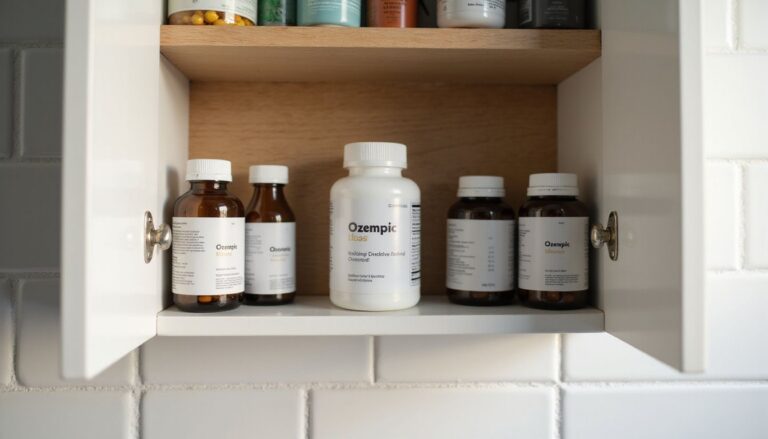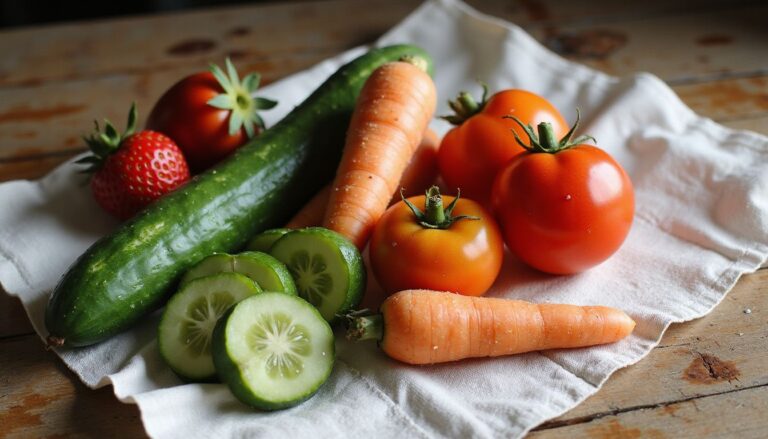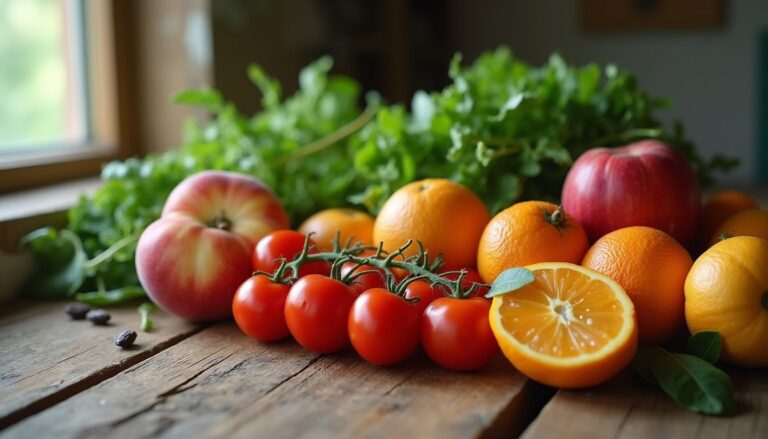Diet Plan For Muscle Gain: 7-Day Meal Prep For Muscle-Building Success
Our Nutrition Assistant AI Suite will transform your body. You will lose fat, get toned, and build muscle. Gain confidence and optimal health.
You train hard, yet muscle gain can stall without the right fuel. A smart meal plan focuses on enough calories, steady protein, and nutrient-dense foods each day. This guide gives you simple meal prep steps, a 7-day meal plan, and clear food lists so you can build muscle with less guesswork.
Follow along if you want practical, evidence-based tips you can use this week.
Key Takeaways
- Protein: Aim for 1.6 to 3.1 grams per kilogram of body weight daily, about 0.7 to 1.4 grams per pound.
- Calories: Eat about 15% above maintenance to gain, then track weight weekly and adjust as needed.
- Macros: A helpful starting split is 30 to 35% protein, 55 to 60% complex carbs, and 15 to 20% healthy fats.
- Best picks: Chicken breast, Greek yogurt, cottage cheese, lentils, whey or plant protein powders.
- What to limit: Ultra-processed foods, deep-fried items, sugary snacks and drinks. Alcohol can cut muscle growth by up to 37% in high doses.
- Meal prep: Batch cook proteins and carbs, portion in BPA-free containers, and store for grab-and-go meals.
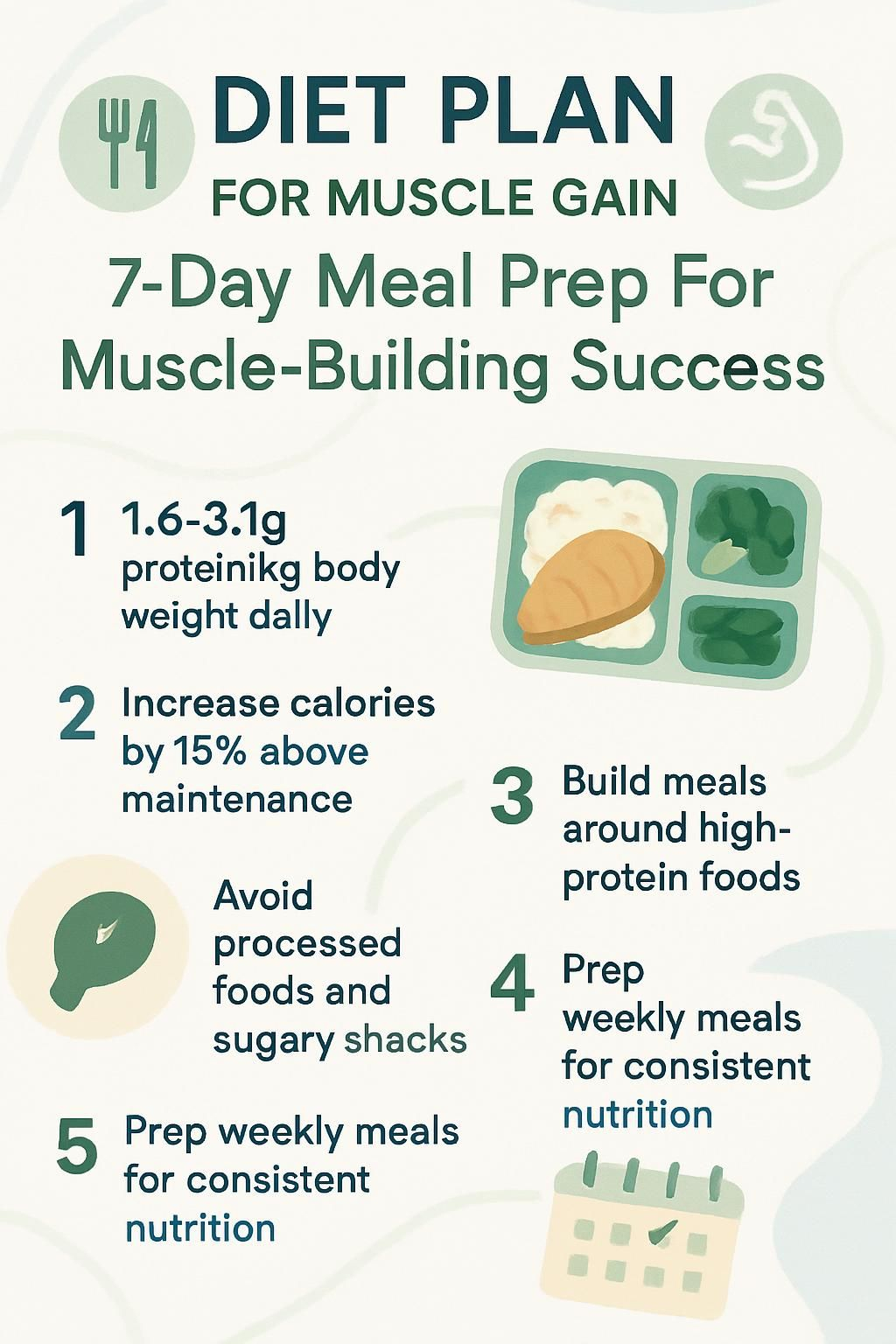
Key Nutrients for Building Muscle
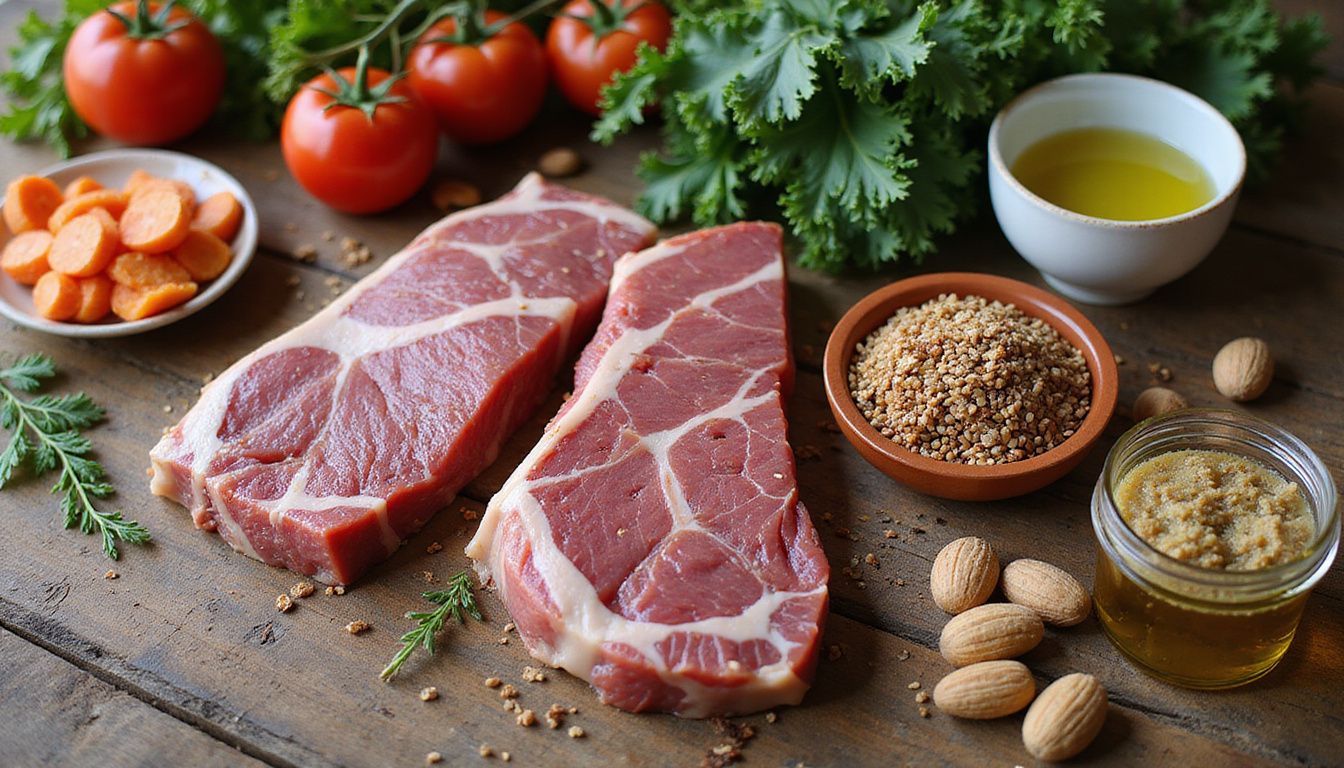
Your muscles respond to training, but food drives the repair. A muscle-building diet balances protein, carbohydrates, and fat to support growth, recovery, and strength.
How Does Protein Help Build Muscle?
Protein is the main material your body uses to repair tiny tears from strength training. Rebuilding those fibers makes them stronger and larger. Skeletal muscle is about 80% protein by dry weight.
Target 1.6 to 3.1 grams of protein per kilogram of body weight each day. That equals about 0.7 to 1.4 grams per pound. For a 150-pound lifter, that is around 105 to 210 grams per day.
Include a quality protein at every meal and snack. Good options are chicken breast, Greek yogurt, whey protein isolate, tofu, tempeh, and cottage cheese. This steady supply supports recovery all day. A simple example, eggs at breakfast, chicken at lunch, and yogurt or tofu at dinner.
Why Choose Complex Carbohydrates?
Carbohydrates power your training and refill glycogen, the stored form of carbs in muscle. Dietitians often suggest 55 to 60% of total calories from carbs for active lifters.
Pick whole sources like oats, brown rice, quinoa, barley, fruit, potatoes, and beans. Pair carbs with protein after lifting to boost glycogen refilling and recovery. Avoid very high-fiber foods right before workouts, since they can cause stomach discomfort during exercise.
What Are the Benefits of Healthy Fats?
Healthy fats should make up 15 to 20% of your daily calories on a muscle-building diet. Fat provides 9 calories per gram and helps you absorb fat-soluble vitamins like vitamin D. Those vitamins support strength and overall health.
Choose olive oil, avocado, nuts, seeds, egg yolks, and full-fat dairy if it fits your calories. Adequate fat supports key hormones such as testosterone that influence muscle growth. Keep high-fat meals away from training, since they digest slowly and may feel heavy.
Summary: Protein rebuilds muscle, complex carbs fuel training and recovery, and healthy fats support hormones and vitamin absorption.
How Do I Create a Muscle-Building Diet?
A clear plan keeps you focused. Set your calories, choose a macro split, and time meals to support training.
How Do I Calculate My Caloric Needs?
Track what you eat and your weight for one week. Use a food app, log everything, and weigh yourself at least three times. If your weight holds steady, that average is your maintenance calories.
To gain, add about 15% to that number. If maintenance is 3,000 calories, aim near 3,450 calories per day. Monitor your trend. Target a weight gain of about 0.5 to 1% of body weight weekly to build mostly lean mass.
What Is the Right Macronutrient Balance?
After setting calories, assign your macros. A helpful starting point is 30 to 35% protein, 55 to 60% carbs, and 15 to 20% fat. Protein and carbs each have 4 calories per gram. Fat has 9 calories per gram.
Example at 3,450 calories: about 259 to 302 grams of protein, 474 to 518 grams of carbs, and 58 to 77 grams of fat. During a cut near 2,550 calories, keep protein high, reduce carbs to fit your needs, and lower fats. Use lean meats, dairy, beans, soy foods, and whole grains to hit targets.
When Should I Eat for Muscle Growth?
Meal timing can help. Eating every 3 to 4 hours keeps amino acids available for repair. Start your day with a protein-rich breakfast.
Before workouts, choose easy-to-digest carbs like toast or oatmeal. Within an hour after training, have 20 to 40 grams of protein plus fast-digesting carbs to support glycogen refilling and muscle repair.
Use protein shakes or yogurt as simple snacks if you struggle to meet targets with meals alone.
Best Foods to Support Muscle Growth
Your grocery choices do the heavy lifting outside the gym. Focus on foods that deliver protein, complex carbs, and healthy fats.
What Are the Top High-Protein Foods?
Build meals around these options:
- Chicken breast, about 31 grams of protein per small piece.
- Whey protein isolate, around 25 grams per scoop, quick to digest.
- Pea protein powder, roughly 24 grams per scoop for plant-based diets.
- Greek yogurt, about 20 grams per cup, supports gut health and recovery.
- Cottage cheese, around 23.5 grams per cup with slow-digesting casein.
- Shrimp or tempeh, about 20 grams per 3 ounces or 100 grams.
- Lentils, about 18 grams per cooked cup, plus helpful fiber.
Mix animal and plant proteins across the week for variety and budget.
Which Carbohydrates Are Best for Muscle Gain?
Pick complex carbs for steady energy:
- Whole grains: oatmeal, quinoa, brown rice, whole-grain bread, and cereal.
- Starchy vegetables: sweet potatoes, corn, green peas, lima beans, and cassava.
- Fruit: bananas, apples, oranges, grapes, pears, peaches, watermelon, and berries.
Post-workout, pair carbs with protein to speed recovery and refill glycogen. This combo supports stronger training over time.
What Healthy Fats Should I Include?
Round out meals with healthy fats that support hormones and help you feel satisfied:
- Oils: olive, avocado, and flaxseed oil.
- Nuts and seeds: almonds, walnuts, sunflower seeds, chia, and flax.
- Other sources: avocados, egg yolks, and full-fat dairy if calories allow.
Plan for 15 to 20% of total calories from fat to support muscle growth without overdoing energy intake.
What Foods Should I Avoid for Muscle Gain?
Some foods fight your goals. Cutting them back creates space for better choices.
Why Avoid Processed Foods and Added Sugars?
Ultra-processed foods and added sugars bring calories with little nutrition. Sodas, candy, cakes, and sweetened drinks can crowd out protein and slow recovery. Diets high in ultra-processed foods link to higher disease risk, including cardiovascular disease.
Choose nutrient-dense foods instead, like eggs, salmon, leafy greens, beans, and colorful vegetables. Whole foods make it easier to hit protein and fiber targets.
Should I Skip Deep-Fried Foods?
Regular deep-fried foods can increase inflammation, which may slow recovery after training. They also add a lot of fat with limited protein. For example, some fried chicken strips can deliver over 20 grams of fat with less than 15 grams of protein, not a helpful ratio for muscle gain.
Pick baked, grilled, or roasted meals to keep nutrients high and fats in check. Your joints and recovery will thank you.
Reference: Mayo Clinic nutrition facts and similar databases are useful for checking restaurant items.
How Does Alcohol Affect Muscle Development?
Alcohol can impair muscle growth by slowing protein synthesis, the process that builds new muscle. High intakes also lower testosterone and raise cortisol, which work against strength gains.
One study reported that large doses, about 1.5 grams per kilogram of body weight in a day, reduced muscle building by up to 37%. If you drink, keep it light, especially around workouts. Give your body the best chance to grow.
7-Day Meal Prep Plan for Muscle Building
Use this simple 7-day meal plan as a model. The energy targets are examples. Adjust portions to your body size, activity level, and goals.
What Meals Should I Eat on Day 1?
Day 1 sample targets: 1,498 calories, 103 grams protein, 131 grams carbs, 28 grams fiber, 60 grams fat.
- Breakfast: Scrambled eggs with mushrooms, oatmeal, and a pear.
- Snack: Low-fat cottage cheese with blueberries.
- Lunch: Venison burger, steamed rice, and broccoli.
- Snack: Whey protein shake and a banana.
- Dinner: Grilled salmon, quinoa, and roasted asparagus.
- Use a drizzle of olive oil for flavor and healthy fats.
- Hydrate through the day to support digestion and recovery.
This day balances quality protein, complex carbs, fiber, and healthy fats.
How to Focus on Plant-Based Proteins on Day 2?
Day 2 shows how to center meals on plants and still build muscle.
- Target about 93 grams of protein from lentils, beans, tempeh, tofu, or pea protein.
- Add soy foods, like edamame or tofu, to stir-fries and salads.
- Include complex carbs such as rice, potatoes, or whole grains with beans.
- Snack on roasted chickpeas or whole-grain toast with hummus.
- Use black beans, kidney beans, and peas to reach about 25 grams of fiber and keep fat near 73 grams.
- Mix in spinach and broccoli for iron, calcium, and vitamin C.
- Aim for about 1,495 calories across your meals and snacks.
Prepping a pot of beans and a tray of roasted vegetables can cover several meals.
What Are Good Post-Workout Meals on Day 3?
Post-workout meals should refill glycogen and provide protein for repair. Day 3 targets: 1,510 calories, 126 grams protein, 124 grams carbs, 29 grams fiber, 57 grams fat.
- Ground chicken with brown rice or quinoa.
- Steamed vegetables like broccoli and carrots for vitamins and fiber.
- Greek yogurt, banana, and whey blended into a shake.
- Yogurt parfait with oats, berries, and chia seeds.
- Whole-wheat toast topped with cottage cheese.
- Roasted sweet potatoes with grilled fish or turkey.
- Hard-boiled eggs with whole-grain crackers or hummus.
- Skip alcohol after training to protect recovery and gains.
- Use creatine or a protein shake if whole-food targets are hard to meet.
- Distribute protein across meals to support steady growth.
How to Balance Healthy Fats and Carbs on Day 4?
Day 4 targets: 1,492 calories, 95 grams protein, 148 grams carbs, 26 grams fiber, 62 grams fat.
- Base each meal on a whole grain like quinoa or brown rice.
- Add avocado or a tablespoon of olive oil at lunch and dinner.
- Include nuts or seeds in snacks for minerals and healthy fats.
- Grill or roast chicken, tofu, or fish with high-fiber vegetables.
- Whole-wheat toast with scrambled eggs and a drizzle of olive oil at breakfast.
- Drink water during the day, keep caffeine moderate after lunch.
- Batch cook rice or sweet potatoes for quick sides.
- Skip deep-fried foods; roast vegetables with olive oil instead.
- Track macros so fat stays near 15 to 20% of calories and carbs reach 55 to 60%.
What Are Quick Meal Ideas for Busy Days on Day 5?
Speed matters on packed days. Day 5 targets: 1,496 calories, 111 grams protein, 100 grams carbs, 29 grams fiber, 75 grams fat.
- Whole-grain turkey or chicken sandwich with spinach.
- Protein shake with whey, almond milk, banana, and peanut butter.
- Tuna mixed with Greek yogurt and celery, served with whole-wheat crackers.
- Boiled eggs for a quick protein snack.
- Overnight oats with chia seeds, berries, and whey.
- Microwaved brown rice topped with grilled salmon and avocado.
- Roasted chickpeas or mixed nuts for crunch and minerals.
- Cottage cheese with pineapple or berries for casein protein.
- Hummus with raw carrots and bell peppers.
- Portion meals into containers at the start of the day.
Which Snacks and Meals Are Protein-Rich on Day 6?
Day 6 aims to keep protein high while balancing carbs and fats. Targets: 1,497 calories, 89 grams protein, 160 grams carbs, 35 grams fiber, 75 grams fat.
- Breakfast: Scrambled eggs with whole-grain toast.
- Snack: Cottage cheese with fruit, about 25 grams of protein per cup.
- Lunch: Grilled chicken breast over leafy greens.
- Snack: Greek yogurt, around 20 grams of protein per cup.
- Dinner: Baked salmon with quinoa and steamed broccoli.
- Grab-and-go: Boiled eggs and a small trail mix with nuts and seeds.
- Optional: Add a scoop of protein powder to the trail mix, if needed.
How to Eat for Rest Day and Muscle Repair on Day 7?
Rest days still count. Feed recovery so you can train hard again.
- Have protein at each meal. Aim for 1.6 to 2.2 grams per kilogram of body weight.
- Include healthy fats like olive oil, nuts, avocado, or salmon.
- Add fiber-rich vegetables and whole grains for gut health.
- Eat every 3 to 4 hours to sustain repair.
- Drink 8 to 10 cups of water, more if using supplements.
- Pick snacks with protein and carbs, like a turkey wrap or cottage cheese with berries.
- Limit ultra-processed foods and deep-fried snacks.
- Avoid alcohol, which can slow protein synthesis and recovery.
- Sleep 7 to 9 hours to support growth and performance.
How Can I Make Meal Prep Easier and More Effective?
Planning turns healthy eating into a repeatable habit. A few simple systems make prep faster and less stressful.
Why Batch Cook Proteins and Carbs?
Batch cooking saves time and keeps your macros on track. Roast chicken, tofu, or lentils while cooking rice or sweet potatoes. In about two hours, you can prep most of the week.
Prepped staples make it easy to portion meals and hit your daily targets. Meal prepping is linked with better dietary consistency over a week, which supports stable progress.
How to Use Containers for Storage?
Good storage keeps food fresh and safe. Use BPA-free, airtight containers. Separate meals into portions so they are ready when you are hungry.
Label with the prep date. Stack containers to save space and avoid mixing raw and cooked foods.
Summary Table:
| Storage Tip | Benefit |
|---|---|
| Use BPA-free plastic | Reduces risk of chemical leaching |
| Separate portions | Supports calorie and macro control |
| Label dates | Makes freshness easy to track |
| Stackable design | Saves refrigerator space |
Color-coding lids, for example blue for post-workout, can help you grab the right meal fast.
How Can I Keep Meal Flavors Interesting?
Rotate proteins, carbs, and fats to prevent boredom. Try chicken on Monday, salmon on Tuesday, tofu midweek. Swap brown rice for quinoa or sweet potatoes. Use olive oil one day and avocado oil the next.
Season boldly. Chili powder, garlic, smoked paprika, curry blends, citrus, and fresh herbs add flavor without many calories. Mix cooking methods too, such as grilling, roasting, and sautéing.
How to Prepare Post-Workout Meals in Advance?
Make recovery automatic. Prep shakes with 20 to 30 grams of protein and a banana. Cook quinoa or rice and pair with grilled chicken. Keep Greek yogurt and berries ready in the fridge.
Eating carbs with about 25 grams of protein within an hour after training supports repair and glycogen refilling. Planning these meals on Sunday keeps the week simple.
What Should I Buy for a Muscle-Building Grocery List?
A strong list helps you shop fast and cook with purpose. Stock your kitchen with foods that support muscle growth and steady energy.
Which Proteins Should I Include?
Pick a mix of animal and plant proteins:
- Lean meats and fish: sirloin steak, ground beef, pork tenderloin, chicken breast, venison, salmon, tilapia, and cod.
- Dairy: yogurt, cottage cheese, low-fat milk, and cheese.
- Plant options: beans, lentils, chickpeas, tofu, and tempeh.
Most meats and fish give about 20 to 25 grams of protein per 3 ounces. A cup of cooked lentils provides about 18 grams. Tempeh can reach 31 grams per cup.
What Carbohydrates Are Essential?
Whole grains and fruits deliver fuel and micronutrients:
- Whole grains: bread, cereal, crackers, oatmeal, quinoa, popcorn, and rice.
- Fruits: oranges, apples, bananas, grapes, pears, peaches, watermelon, and berries.
- Starchy vegetables: sweet potatoes, corn, green peas, lima beans, and cassava.
These choices help refill glycogen and support hard training days.
Which Healthy Fats Are Recommended?
Choose fats that support heart health and vitamin absorption:
- Oils: olive, avocado, and flaxseed oil, about 14 grams of fat per tablespoon for olive oil.
- Nuts and seeds: almonds, walnuts, sunflower seeds, chia seeds, and flax seeds.
- Other sources: avocados and full-fat Greek yogurt if your calories allow.
These foods add flavor and help you meet your energy needs without relying on fried items.
What Vegetables Support Muscle Growth?
Vegetables supply fiber, vitamins, and compounds that aid blood flow and recovery:
- Everyday picks: broccoli, green beans, cucumbers, zucchini, asparagus, peppers, mushrooms, and tomatoes.
- Leafy greens: spinach, kale, arugula, and lettuce, which are rich in nitrates that may support performance.
Include several colors each day to cover a wide range of nutrients.
Which Dietary Supplements Help Muscle Gain?
Supplements can fill gaps, but food should be your base. Consider these options if your diet needs support.
How Does Whey Protein Support Muscle Building?
Whey offers fast-digesting protein that supports repair after workouts. A typical scoop gives about 25 grams of high-quality protein. Add it to smoothies or oatmeal to reach your daily target.
What Are the Benefits of Creatine?
Creatine helps you produce quick energy for short, intense efforts. Research shows creatine monohhydrate can increase strength and muscle size in people who lift. A common dose is 3 to 5 grams per day.
Speak with your healthcare provider before starting any new supplement.
How Can Omega-3 Reduce Muscle Pain?
Omega-3 fats, found in fish oil and flaxseed oil, can lower muscle soreness after tough sessions. Some studies report less delayed-onset muscle soreness in athletes who supplement with omega-3s.
These fats may help you train consistently by easing discomfort between workouts.
How Can I Overcome Challenges in a Muscle-Building Diet?
Life gets busy. A few small habits can keep you on track and reduce stress around food.
How to Stay Consistent with Meal Prep?
Prep proteins and complex carbs at the start of the week. Chop vegetables, cook rice or quinoa, and grill chicken or tofu in one session. Use quality containers so meals are easy to grab.
Plan your menu on a calendar or app. Rotate recipes every week or two to keep flavors fresh.
When Should I Adjust My Caloric Intake?
Track your weight three times a week at the same time of day. If weight is not moving or changes less than 0.5% per week, increase calories slightly. If you are gaining faster than 1% per week, reduce calories to limit fat gain.
Recheck your maintenance and bulking calories each month as your body changes.
How Can I Manage Cravings for Junk Food?
Higher protein helps control hunger and cravings. Keep easy options on hand, like Greek yogurt, mixed nuts, fruit, or air-popped popcorn. Measure snacks into bowls or bags so portions stay reasonable.
Choose tasty swaps, like roasted chickpeas instead of chips, or low-fat cheese sticks instead of candy. A wide variety of whole foods keeps your taste buds satisfied and supports your goals.
Conclusion
Progress in the gym depends on what you eat. Build a simple 7-day meal plan that centers on whole foods, steady protein, complex carbs, and healthy fats. Limit ultra-processed foods, deep-fried items, added sugar, and alcohol.
Track intake with an app, review your weight trend, and adjust calories as needed. If you have a medical condition or special needs, talk with a registered dietitian or your doctor. Small, consistent steps today help you gain lean muscle over time.
Disclaimer: This article is for education only and is not medical advice. Consult a qualified professional for personalized guidance.
FAQs
1. What is the main goal of a 7-day meal prep for muscle-building success?
A 7-day meal prep aims to provide consistent, nutrient-rich meals that support muscle growth. Each day’s plan includes balanced portions of protein, complex carbohydrates, and healthy fats. This structure helps maintain energy levels and supports recovery after strength training.
2. How much protein should I include in my diet plan for muscle gain?
Research suggests adults seeking muscle gain should consume about 0.7 to 1 gram of protein per pound of body weight daily (Phillips & Van Loon, 2011). For example, a person weighing 150 pounds would need between 105 and 150 grams each day.
3. Can I customize the meal prep if I have dietary restrictions or preferences?
Yes; you can adjust ingredients while keeping macronutrient targets intact. Swapping chicken with tofu or lentils provides plant-based options without sacrificing protein content.
4. Why is tracking nutritional intake important during a week-long meal plan for building muscle?
Tracking calories and nutrients ensures your body receives enough fuel for workouts and recovery periods (Slater et al., 2019). Monitoring intake also helps identify gaps in vitamins or minerals that could affect progress toward your goals.
Summary: A structured weekly eating schedule focused on adequate protein, balanced macros, and careful monitoring supports effective muscle development over time. Adjustments allow flexibility without compromising results when following evidence-based guidelines.


